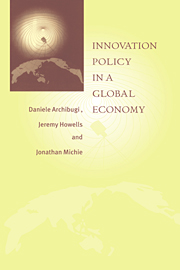Book contents
- Frontmatter
- Contents
- List of figures
- List of tables
- List of contributors
- Foreword
- Preface and acknowledgements
- 1 Innovation systems and policy in a global economy
- Part I National systems of innovation
- Part II Regional, national and global forces
- Part III Globalisation and economic performance
- 9 The political economy of globalisation
- 10 The geographical sourcing of technology-based assets by multinational enterprises
- 11 Innovation as the principal source of growth in the global economy
- 12 The policy implications of the globalisation of innovation
- Index
12 - The policy implications of the globalisation of innovation
Published online by Cambridge University Press: 05 November 2009
- Frontmatter
- Contents
- List of figures
- List of tables
- List of contributors
- Foreword
- Preface and acknowledgements
- 1 Innovation systems and policy in a global economy
- Part I National systems of innovation
- Part II Regional, national and global forces
- Part III Globalisation and economic performance
- 9 The political economy of globalisation
- 10 The geographical sourcing of technology-based assets by multinational enterprises
- 11 Innovation as the principal source of growth in the global economy
- 12 The policy implications of the globalisation of innovation
- Index
Summary
Introduction
Globalisation is not a single phenomenon, but a catch-all concept to describe a wide range of forces. The importance of globalisation is currently the focus of a vivid controversy. On the one hand, there are those who maintain that globalisation has effectively contaminated the greater part of economic life (Ohmae, 1990; Chesnais, 1994; Barnet and Cavanagh, 1994; Brecher and Costello, 1994; Perraton et al., 1997); on the other, there are those who take a more sceptical view (Ruigrok and van Tulder, 1995; Michie and Grieve Smith, 1995; Hirst and Thompson, 1996). However, the terms of the debate are often unclear as three issues, which although related should be kept separate, are not well clarified.
The first is to establish the importance of global forces in social life (does globalisation exist or not?). This requires the identification of the different types of globalisation and an estimate of their weight according to geographical location, industrial sectors and social groupings. The second refers to the value judgement attributable to globalisation (is a global society a good or a bad thing?). Answers to this type of question can only be given by clarifying the actors of reference. Finally, the third issue refers to the viability of national policies enabling the modification of the inertial tendencies produced by globalisation (are there any policies which can regulate globalisation?). As these policies are mainly implemented at a national level, the debate on globalisation must necessarily be judged with reference to the effectiveness of the policies implemented by national governments.
In this chapter,we attempt to critically assess the concept of globalisation as applied to innovation. Our intention is to define its implications for national policies.
- Type
- Chapter
- Information
- Innovation Policy in a Global Economy , pp. 242 - 271Publisher: Cambridge University PressPrint publication year: 1999
- 10
- Cited by

